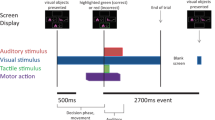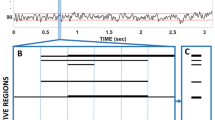A new concept of brain functions is proposed. According to it, the brain is a hierarchy of neural optimal control systems where each level possesses a dynamic model of its controlled object; this can be a lower control level in the CNS or an executive organ. The new concept of brain functions is based on the solution of the problem of central pattern generators and on the neural network computational principle. Contemporary data on the cerebellum, cortico-basal ganglia-thalamo-cortical loops (the structural/functional basis of the highest brain levels), Parkinson’s disease, and methods of its treatment (including deep brain stimulation) are analyzed from the point of view of the new concept of brain functions. These examples demonstrate the universal applicability of the new concept in the investigation of the physiology and pathophysiology of neural networks and the respective clinical effects.
Similar content being viewed by others
Literature
C. S. Sherrington, The Integrative Action of the Nervous System, Yale Univ. Press, New Haven (1947).
P. A. Getting, “Understanding central pattern generators: insights gained from the study of invertebrate systems,” In: Neurobiology of Vertebrate Locomotion, S. Grillner, P. S. G. Stein, et al. (eds.), Macmillan Press, London (1986), pp. 231–244.
K. V. Baev, V. B. Esipenko, and Y. P. Shimansky, “Afferent control of central pattern generators: experimental analysis of scratching in the decerebrate cat,” Neuroscience, 40, No. 1, 239–256 (1991).
K. V. Baev, V. B. Esipenko, and Y. P. Shimansky, “Afferent control of central pattern generators: experimental analysis of locomotion in the decerebrate cat,” Neuroscience, 43, No. 1, 237–247 (1991).
K. V. Baev, “Depolarization of different lumbar afferent terminals during fictitious scratching,” Neurophysiology (in Russian), 11, No. 6, 569–577 (1979).
K. V. Baev, “Polarization of lumbar primary afferent terminals during fictitious locomotion,” Neurophysiology (in Russian), 12, No. 5, 481–489 (1980).
K. V. Baev and P. G. Kostyuk, “Primary afferent depolarization evoked by activity of spinal scratching generator,” Neuroscience, 6, 205–215 (1981).
K. V. Baev and P. G. Kostyuk, “Polarization of primary afferent terminals of lumbosacral cord elicited by activity of spinal locomotor generator,” Neuroscience, 7, 1401–1409 (1982).
T. G. Brown, “On the nature of the fundamental activity of the nervous centres, together with an analysis of the conditioning of rhythmic activity in progression, and a theory of the evolution of function in the nervous system,” J. Physiol., 48, No. 1, 18–46 (1914).
F. Brocard, S. Tazerart, and L. Vinay, “Do pacemakers drive the central pattern generator for locomotion in mammals?” Neuroscientist, 16, No. 2, 139–155 (2010).
J. T. Buchanan, “Flexibility in the patterning and control of axial locomotor networks in lamprey,” Integr. Comp. Biol., 51, No. 6, 869–878 (2011).
L. M. Jordan and U. Slawinska, “Chapter 12-modulation of rhythmic movement: control of coordination,” Prog. Brain Res., 188, 181–195 (2011).
O. Kiehn and K. Kullander, “Central pattern generators deciphered by molecular genetics,” Neuron, 42, No. 3, 317–321 (2004).
I. N. Bronshtein and K. A. Semendyayev, Handbook of Mathematics, Springer-Verlag, Berlin, Heidelberg (1998).
V. Hamburger, “Some aspects of the embryology of behavior,” Quart. Rev. Biol., 38, 342–365 (1963).
V. Hamburger and M. Balaban, “Observations and experiments on spontaneous rhythmical behavior in the chick embryo,” Dev. Biol., 7, 533–545 (1963).
V. Hamburger and R. Oppenheim, “Prehatching motility and hatching behavior in the chick,” J. Exp. Zool., 166, No. 2, 171–203 (1967).
A. N. Kolmogorov, “On the representation of continuous functions of many variables by superposition of continuous functions of one variable and addition,” Dokl. Akad. Nauk USSR [in Russian], 114, 953–956 (1957).
L. M. Mendell and E. Henneman, “Terminals of single 1a fibers: Distribution within a pool of 300 homonymous motor neurons,” Science, 160, No. 3823, 96–98 (1968).
L. M. Mendell and E. Henneman, “Terminals of single 1a fibers: Location, density, and distribution within a pool of 300 homonymous motoneurons,” J. Neurophysiol., 34, No. 1, 171–187 (1971).
K. V. Baev, “Learning in systems controlling motor automatisms,” Rev. Neurosci., 5, 55–87 (1994).
M. D. Crutcher and M. R. Delong, “Single cell studies of the primate putamen. II. Relations to direction of movement and pattern of muscular activity,” Exp. Brain Res. Exp. Hirnforsch. Exp. Cerebr., 53, No. 2, 244–258 (1984).
M. D. Crutcher and M. R. Delong, “Single cell studies of the primate putamen. I. Functional organization,” Exp. Brain Res. Exp. Hirnforsch. Exp. Cerebr., 53, No. 2, 233–243 (1984).
T. Kobayashi, H. Nishijo, M. Fukuda, et al., “Taskdependent representations in rat hippocampal place neurons,” J. Neurophysiol., 78, No. 2, 597–613 (1997).
L. E. Sergio and J. F. Kalaska, “Systematic changes in directional tuning of motor cortex cell activity with hand location in the workspace during generation of static isometric forces in constant spatial directions,” J. Neurophysiol., 78, No. 2, 1170–1174 (1997).
L. E. Sergio and J. F. Kalaska, “Systematic changes in motor cortex cell activity with arm posture during directional isometric force generation,” J. Neurophysiol., 89, No. 1, 212–228 (2003).
K. V. Baev, “A new conceptual understanding of brain function: basic mechanisms of brain-initiated normal and pathological behaviors,” Crit. Rev. Neurobiol., 19, Nos. 2/3, 119–202 (2007).
K. V. Baev and Y. P. Shimansky, “Principles of organization of neural systems controlling automatic movements in animals,” Prog. Neurobiol., 39, No. 1, 45–112 (1992).
Y. I. Arshavsky, I. M. Gelfand, and G. N. Orlovsky, Cerebellum and Rhythmic Movements, Springer-Verlag, Berlin (1986).
J. Eccles, M. Ito, and J. Szentagothai, The Cerebellum as a Neuronal Machine, Springer-Verlag, Berlin (1967).
G. E. Alexander, M. D. Crutcher, and M. R. Delong, “Basal ganglia-thalamocortical circuits: Parallel substrates for motor, oculomotor, “prefrontal” and “limbic” functions,” Prog. Brain Res., 85, 119–146 (1990).
G. E. Alexander, M. R. Delong, and P. L. Strick, “Parallel organization of functionally segregated circuits linking basal ganglia and cortex,” Annu. Rev. Neurosci., 9, 357–381 (1986).
P. Apicella, E. Scarnati, T. Ljungberg, and W. Schultz, “Neuronal activity in monkey striatum related to the expectation of predictable environmental events,” J. Neurophysiol., 68, No. 3, 945–960 (1992).
T. Ljungberg, P. Apicella, and W. Schultz, “Responses of monkey dopamine neurons during learning of behavioral reactions,” J. Neurophysiol., 67, No. 1, 145–163 (1992).
W. Schultz, “Predictive reward signal of dopamine neurons,” J. Neurophysiol., 80, No. 1, 1–27 (1998).
K. V. Baev, “Disturbances of learning processes in the basal ganglia in the pathogenesis of Parkinson’s disease: a novel theory,” Neurol. Res., 17, No. 1, 38–48 (1995).
K. V. Baev, “Highest level automatisms in the nervous system: a theory of functional principles underlying the highest forms of brain function,” Progr. Neurobiol., 51, 129–166 (1997).
K. V. Baev, Biological Neural Networks: Hierarchical Concept of Brain Function, Birkhauser, Boston (1998).
K. V. Baev, K. A. Greene, F. F. Marciano, et al., “Physiology and pathophysiology of cortico-basal ganglia-thalamocortical loops: theoretical and practical aspects,” Prog. Neuropsychopharmacol. Biol. Psychiat., 26, No. 4, 771–804 (2002).
C. R. Butson and C. C. Mcintyre, “Role of electrode design on the volume of tissue activated during deep brain stimulation,” J. Neural. Eng., 3, No. 1, 1–8 (2006).
C. Hamani, J. A. Saint-Cyr, J. Fraser, et al., “The subthalamic nucleus in the context of movement disorders,” Brain, 127, Part 1, 4–20 (2004).
M. Goard and Y. Dan, “Basal forebrain activation enhances cortical coding of natural scenes,” Nat. Neurosci., 12, No. 11, 1444–1449 (2009).
P. K. Anokhin, Biology and Neurophysiology of Conditioned Reflex and Its Role in Adaptive Behavior, Pergamon Press, Oxford (1974).
N. A. Bernstein, Sketches on Physiology of Movements and Physiology of Activity (in Russian), Meditzina, Moskow (1966).
E. von Holst, “Relations between the central nervous system and the peripheral organ,” Br. J. Anim. Behav., 2, 89–94 (1954).
N. Chub and M. J. O’donovan, “Blockade and recovery of spontaneous rhythmic activity after application of neurotransmitter antagonists to spinal networks of the chick embryo,” J. Neurosci., 18, No. 1, 294–306 (1998).
J. Bickle, Psychoneural Reduction: The New Wave, Mit Press, Cambridge, Ma (1998).
Author information
Authors and Affiliations
Corresponding author
Rights and permissions
About this article
Cite this article
Baev, K.V. Solution of the Problem of Central Pattern Generators and a New Concept of Brain Functions. Neurophysiology 44, 414–432 (2012). https://doi.org/10.1007/s11062-012-9313-x
Received:
Published:
Issue Date:
DOI: https://doi.org/10.1007/s11062-012-9313-x




